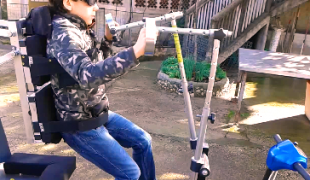- 10849
- 625
- 14
- 16
- 0
- Help Ukraine
About the solution
She began exploring ways to live life more fully, creating tools to help her walk further, ski faster and climb higher. Drawing on her personal experiences has given Sarah the unique insight to create the products and accessories that help others on their journey to reclaim their independence.
People who use forearm crutches often experience overuse injuries due to poor design and lack of innovation. SideStix has made innovative crutch designs that aim to make people more comfortable and help to reduce injuries. "We wanted to understand whether these new crutch designs changed how force is applied during walking compared to traditional crutches", says on the official website.
So they made a study in the Human Locomotion Lab at the Blusson Spinal Cord Centre at ICORD in Vancouver with 13 healthy non-disabled people. The findings of this study was the boundless crutch reduced strain on arms (how force is spread out over time), helped reduce forces up and down (vertically) as well as forward/backward (braking) and increased propulsive force and (extra spring forward) which conserve energy when moving forward.
Sarah climbed Kilamanjaro and become the first amputee on Mt. McKinley.
Adapted from: http://sarahdoherty.com/about-sarah-doherty/
More information: http://www.sidestix.com/
https://www.youtube.com/watch?v=wmIODSUCQxU
This solution shall not include mention to the use of drugs, chemicals or biologicals (including food); invasive devices; offensive, commercial or inherently dangerous content. This solution was not medically validated. Proceed with caution! If you have any doubts, please consult with a health professional.
DISCLAIMER: This story was written by someone who is not the author of the solution, therefore please be advised that, although it was written with the utmost respect for the innovation and the innovator, there can be some incorrect statements. If you find any errors please contact the patient Innovation team via info@patient-innovation.com
-
-
738
-
0
-
10517

Patient develops cane to grab stuff
Grip
WALKING: Walking
WALKING WITH A WALKING AID: Walking with a walking aid
Kyphosis
Scoliosis
Bone Disorders (Decalcification, Bone Deformity, Bone Fracture, Bone Infection)
Limb Deformity
Congenital Defects (Coarctation of the Aorta, Dextrocardia, Septal Defects)
Assistive Daily Life Device (to help ADL)
Walking Aid (wheelchair/walker/crutches)
Difficulty walking or moving
Muscle weakness
Limited range of motion
Muscle pain or stiffness
Reduced grip force (grip)
Loss of muscle coordination
Muscle cramps or spasms
Joint deformity
Joint redness or warmth
Swelling or inflammation
Fatigue
Numbness or weakness in the legs
Swelling/edema of the legs or ankles.
Joint pain or swelling
Shortness of breath
Restoring mobility
Maintaining Balance and Mobility
Preventing (Vaccination, Protection, Falls, Research/Mapping)
Cardiology
General and Family Medicine
Medical Genetics
Orthopedics
Rheumatology
United States
-
-
-
714
-
0
-
9337

Former wheelchair user creates open source wheelchair
WALKING WITH A WALKING AID: Walking with a walking aid
Post-Polio Syndrome
Muscular Dystrophy
Neuromuscular Disorders
Cerebral Palsy
Cervical spinal cord injury/Tetraplegia
Walking Aid (wheelchair/walker/crutches)
Assistive Daily Life Device (to help ADL)
Muscle cramps or spasms
Difficulty coordinating movements
Stiffness or rigidity (difficulty moving)
Paralysis of the legs and lower body
Muscle weakness
Restoring mobility
Promoting self-management
Managing Neurological Disorders
Maintaining Balance and Mobility
Preventing (Vaccination, Protection, Falls, Research/Mapping)
General and Family Medicine
Infectious Diseases
Medical Genetics
Neurology
Orthopedics
Public Health
Kenya
-
-
-
598
-
3
-
8567

I'VE PATENTED A MACHINERY THAT ALLOWS TO PHYSYCALLY IMPAIRED TO WALK :)
WALKING WITH A WALKING AID: Walking with a walking aid
WALKING: Walking
MOVING IN A WHEELCHAIR: Moving using a wheelchair.
Muscular Dystrophy
Muscle Tone Abnormalities
Brain Injury (Abscess, Brain Barrier Defect, Brain Contusion, Brain Hemorrhage, Brain Edema)
Neuromuscular Disorders
Cerebral Palsy
Walking Aid (wheelchair/walker/crutches)
Assistive Daily Life Device (to help ADL)
Difficulty coordinating movements
Stiffness or rigidity (difficulty moving)
Paralysis of the legs and lower body
Muscle weakness
Restoring mobility
Managing Neurological Disorders
Preventing (Vaccination, Protection, Falls, Research/Mapping)
General and Family Medicine
Medical Genetics
Neurology
Orthopedics
Pediatrics
Italy
-
 en
en